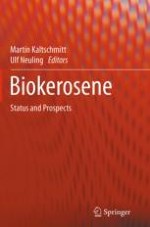Abstract
The introduction of biokerosene as an alternative to conventional fossil kerosene is driven by the intention to reduce greenhouse gas (GHG) emissions, to reduce dependency on fossil energy carriers and by the potential to create economic benefits especially in rural areas. In this paper, sustainability aspects of biokerosene are discussed for a wide range of feedstocks and conversion pathways with regards to environmental and socio-economic consequences.
From an environmental perspective, results show that the use of biokerosene can reduce GHG emissions compared to the use of conventional jet fuel. However, this is strongly dependent on direct and indirect land-use change effects, which could even lead to a considerable increase in emissions. Emission benefits might be alleviated to some extent by non-CO2 emissions from combustion. The cultivation of feedstock affects soil and water quality by soil carbon loss, soil erosion and leaching of nutrients and agrochemicals etc. Appropriate management practices can reduce negative consequences. Impacts are furthermore dependent on land-use history and crop type: certain crops, for example, can improve soil quality. The assessment of land requirements shows that algae, switchgrass, miscanthus, sugarcane and oil palm yield the highest quantity of fuels per hectare. Scientific literature reports predominantly negative impacts of biofuels on biodiversity. These negative consequences can be alleviated by the use of wastes and lignocellulosic residues.
Regarding socio-economic aspects, the assessment shows that none of the assessed fuel pathways is financially competitive with conventional kerosene, even assuming a mature provision technology. The provision of valuable co-products or the taxation of fossil fuels present ways to facilitate the introduction of biokerosene. Furthermore, the effect of biofuels on food prices and volatility of food prices is discussed. Most scientific literature reports increasing food prices due to existing biofuel policy. However, embedded in a flexible regulative context, biofuels could reduce price volatility. The analysis furthermore reveals that biofuels trigger investment and create employment and income in rural areas.
Most environmental and socio-economic consequences are dependent on the feedstock, conversion pathway, local environmental, socio-economic conditions, market structures and the political context. The overview of several key aspects of sustainability provided in this study underlines the importance of an individual sustainability assessment in order to optimize benefits and minimize negative consequences of biokerosene provision and use. It becomes furthermore evident that many negative impacts are inherent to agricultural production in general and that these aspects need to be discussed in a wider context than that of biofuels alone. Doing so could promote synergies of food, fiber and fuel production and facilitate a sustainable use of resources.
